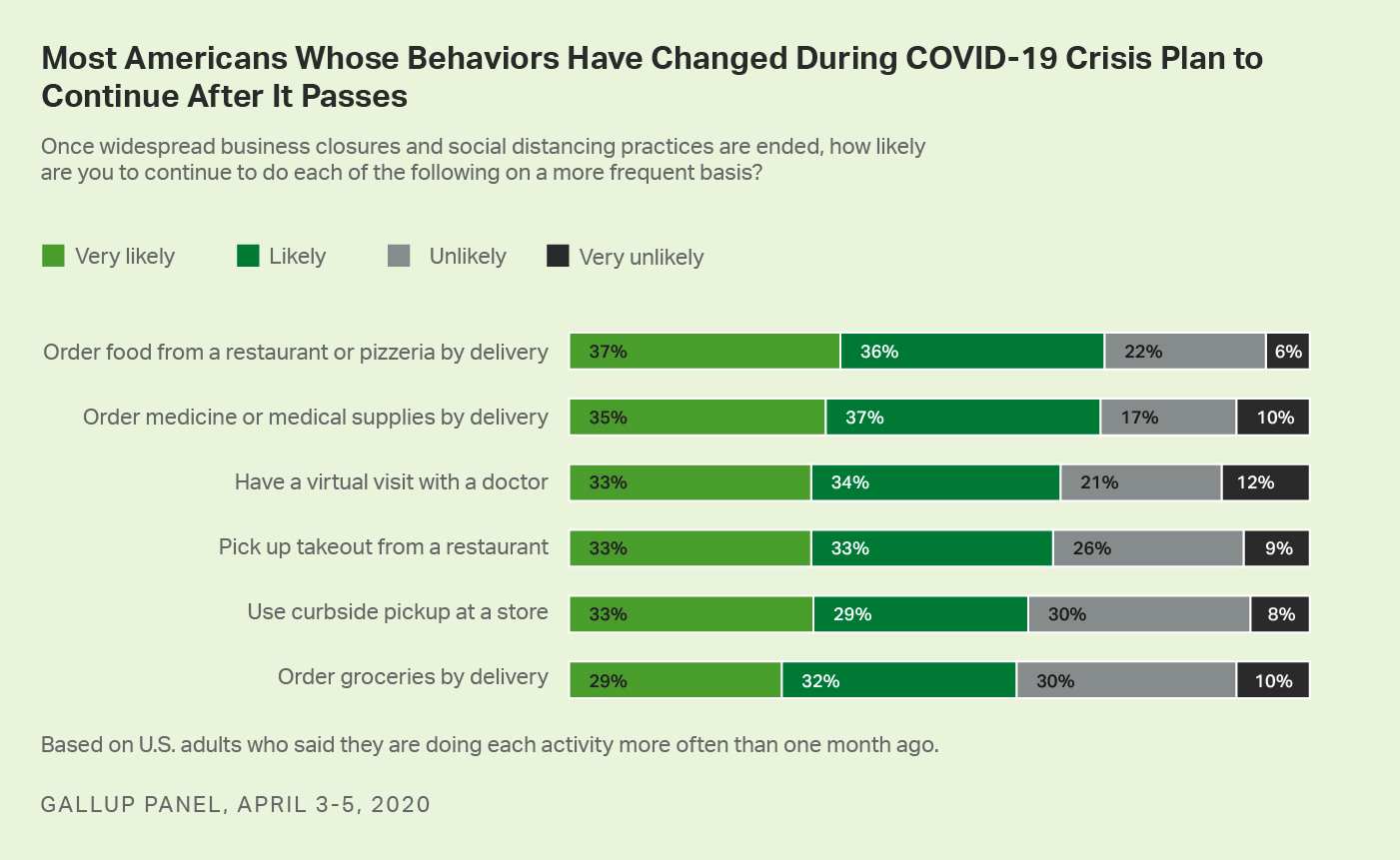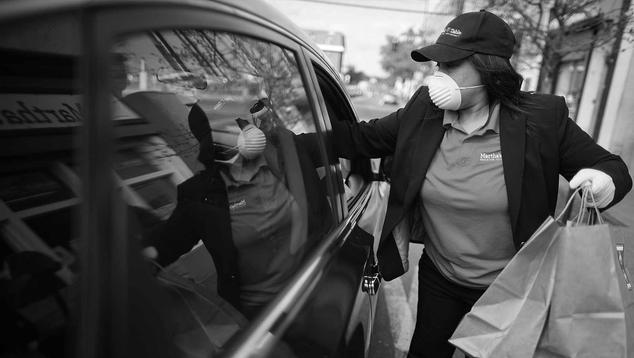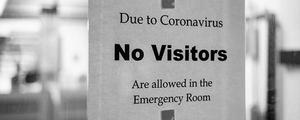Story Highlights
- Greatest increases in restaurant takeout and store curbside pickup
- 14% say they are having groceries delivered more since COVID-19 crisis
- 61%-73% of those using services more now say they're likely to continue post-crisis
WASHINGTON, D.C. -- With an estimated 95% of Americans currently under stay-at-home orders of some kind, restaurants, stores and healthcare companies across the country are offering customers opportunities for low- or no-contact services. However, Gallup finds that most Americans have not been using these services, which typically allow the public to comply with social distancing guidelines while obtaining essential goods and services, more often than they did a month ago.
Picking up takeout food from a restaurant is the service that the most people, 28%, say they have been doing more often in recent weeks. No more than 22% of Americans report that in the past month they have been using each of five other such services more often than usual, as social distancing requirements have intensified. These include home delivery of medicine or medical supplies (5%) or groceries (14%), virtual doctor visits (14%), food delivery from a restaurant (15%) and curbside pickup at stores (22%).
| Mar 27-29 | Mar 30-Apr 2 | Apr 3-5 | ||||||||||||||||||||||||||||||||||||||||||||||||||||||||||||||||||||||||||||||||||||||||||||||||||
|---|---|---|---|---|---|---|---|---|---|---|---|---|---|---|---|---|---|---|---|---|---|---|---|---|---|---|---|---|---|---|---|---|---|---|---|---|---|---|---|---|---|---|---|---|---|---|---|---|---|---|---|---|---|---|---|---|---|---|---|---|---|---|---|---|---|---|---|---|---|---|---|---|---|---|---|---|---|---|---|---|---|---|---|---|---|---|---|---|---|---|---|---|---|---|---|---|---|---|---|---|
| % | % | % | ||||||||||||||||||||||||||||||||||||||||||||||||||||||||||||||||||||||||||||||||||||||||||||||||||
| Picked up takeout from a restaurant | ||||||||||||||||||||||||||||||||||||||||||||||||||||||||||||||||||||||||||||||||||||||||||||||||||||
| More often | 26 | 25 | 28 | |||||||||||||||||||||||||||||||||||||||||||||||||||||||||||||||||||||||||||||||||||||||||||||||||
| About the same | 27 | 25 | 24 | |||||||||||||||||||||||||||||||||||||||||||||||||||||||||||||||||||||||||||||||||||||||||||||||||
| Less often | 24 | 27 | 27 | |||||||||||||||||||||||||||||||||||||||||||||||||||||||||||||||||||||||||||||||||||||||||||||||||
| Have never done/Doesn't apply | 23 | 23 | 20 | |||||||||||||||||||||||||||||||||||||||||||||||||||||||||||||||||||||||||||||||||||||||||||||||||
| Used curbside pickup at a store | ||||||||||||||||||||||||||||||||||||||||||||||||||||||||||||||||||||||||||||||||||||||||||||||||||||
| More often | 16 | 18 | 22 | |||||||||||||||||||||||||||||||||||||||||||||||||||||||||||||||||||||||||||||||||||||||||||||||||
| About the same | 9 | 8 | 8 | |||||||||||||||||||||||||||||||||||||||||||||||||||||||||||||||||||||||||||||||||||||||||||||||||
| Less often | 5 | 4 | 5 | |||||||||||||||||||||||||||||||||||||||||||||||||||||||||||||||||||||||||||||||||||||||||||||||||
| Have never done/Doesn't apply | 70 | 70 | 66 | |||||||||||||||||||||||||||||||||||||||||||||||||||||||||||||||||||||||||||||||||||||||||||||||||
| Had food from a restaurant or pizzeria delivered | ||||||||||||||||||||||||||||||||||||||||||||||||||||||||||||||||||||||||||||||||||||||||||||||||||||
| More often | 10 | 12 | 15 | |||||||||||||||||||||||||||||||||||||||||||||||||||||||||||||||||||||||||||||||||||||||||||||||||
| About the same | 25 | 24 | 21 | |||||||||||||||||||||||||||||||||||||||||||||||||||||||||||||||||||||||||||||||||||||||||||||||||
| Less often | 22 | 22 | 22 | |||||||||||||||||||||||||||||||||||||||||||||||||||||||||||||||||||||||||||||||||||||||||||||||||
| Have never done/Doesn't apply | 43 | 41 | 42 | |||||||||||||||||||||||||||||||||||||||||||||||||||||||||||||||||||||||||||||||||||||||||||||||||
| Had groceries delivered | ||||||||||||||||||||||||||||||||||||||||||||||||||||||||||||||||||||||||||||||||||||||||||||||||||||
| More often | 8 | 10 | 14 | |||||||||||||||||||||||||||||||||||||||||||||||||||||||||||||||||||||||||||||||||||||||||||||||||
| About the same | 8 | 6 | 7 | |||||||||||||||||||||||||||||||||||||||||||||||||||||||||||||||||||||||||||||||||||||||||||||||||
| Less often | 5 | 4 | 4 | |||||||||||||||||||||||||||||||||||||||||||||||||||||||||||||||||||||||||||||||||||||||||||||||||
| Have never done/Doesn't apply | 80 | 80 | 75 | |||||||||||||||||||||||||||||||||||||||||||||||||||||||||||||||||||||||||||||||||||||||||||||||||
| Had a virtual visit with a doctor | ||||||||||||||||||||||||||||||||||||||||||||||||||||||||||||||||||||||||||||||||||||||||||||||||||||
| More often | 11 | 11 | 14 | |||||||||||||||||||||||||||||||||||||||||||||||||||||||||||||||||||||||||||||||||||||||||||||||||
| About the same | 6 | 4 | 6 | |||||||||||||||||||||||||||||||||||||||||||||||||||||||||||||||||||||||||||||||||||||||||||||||||
| Less often | 2 | 3 | 3 | |||||||||||||||||||||||||||||||||||||||||||||||||||||||||||||||||||||||||||||||||||||||||||||||||
| Have never done/Doesn't apply | 81 | 83 | 78 | |||||||||||||||||||||||||||||||||||||||||||||||||||||||||||||||||||||||||||||||||||||||||||||||||
| Had medicine or medical supplies delivered | ||||||||||||||||||||||||||||||||||||||||||||||||||||||||||||||||||||||||||||||||||||||||||||||||||||
| More often | 4 | 4 | 5 | |||||||||||||||||||||||||||||||||||||||||||||||||||||||||||||||||||||||||||||||||||||||||||||||||
| About the same | 14 | 14 | 15 | |||||||||||||||||||||||||||||||||||||||||||||||||||||||||||||||||||||||||||||||||||||||||||||||||
| Less often | 3 | 2 | 2 | |||||||||||||||||||||||||||||||||||||||||||||||||||||||||||||||||||||||||||||||||||||||||||||||||
| Have never done/Doesn't apply | 79 | 80 | 77 | |||||||||||||||||||||||||||||||||||||||||||||||||||||||||||||||||||||||||||||||||||||||||||||||||
| GALLUP PANEL, 2020 | ||||||||||||||||||||||||||||||||||||||||||||||||||||||||||||||||||||||||||||||||||||||||||||||||||||
These findings are based on an online, probability-based Gallup Panel survey conducted April 3-5 as a growing number of states limited restaurants to takeout food only and ordered essential stores to restrict the number of shoppers who can be in the store at one time. Gallup has been tracking the data since March 27, and analysis shows a slight uptick in Americans' increased use of grocery delivery services (+6 percentage points), curbside pickup at a store (+6 points) and delivery from a restaurant (+5 points) over the 10-day period.
Still, at least two-thirds of Americans say they have never used store curbside pickup (66%), had home delivery of groceries (75%) or medicine/medical supplies (77%), or had a virtual doctor visit (78%).
Although delivery and pickup of food from a restaurant are more commonly used services, more than one in five say they are using each less often in the past month. Concerns about contracting the virus from food prepared outside of one's home, a desire to save money in a tough economic climate or the closure of some restaurants may explain this change.
Demographic Differences in Use of Convenience Services
There are several significant demographic differences in Americans' use of some of these services:
- Age -- U.S. adults younger than 35 are more likely than those who are older to be picking up restaurant takeout food more often now than before the crisis. Similarly, 18- to 34-year-olds are more likely than those 55 and older to have had food delivered from a restaurant and used curbside store pickup.
- Income -- Americans in households with annual incomes of at least $90,000 are more likely than those with incomes under $90,000 to say they are getting takeout and delivery from restaurants, using curbside store pickup and having groceries delivered more often now.
- Urbanicity -- Those living in cities or suburbs are more likely than those in small towns or rural areas to say they are having food delivered from a restaurant and having groceries delivered.
| Picked up restaurant takeout | Had food delivery from a restaurant | Used curbside store pickup | Had groceries delivered | |||||||||||||||||||||||||||||||||||||||||||||||||||||||||||||||||||||||||||||||||||||||||||||||||
|---|---|---|---|---|---|---|---|---|---|---|---|---|---|---|---|---|---|---|---|---|---|---|---|---|---|---|---|---|---|---|---|---|---|---|---|---|---|---|---|---|---|---|---|---|---|---|---|---|---|---|---|---|---|---|---|---|---|---|---|---|---|---|---|---|---|---|---|---|---|---|---|---|---|---|---|---|---|---|---|---|---|---|---|---|---|---|---|---|---|---|---|---|---|---|---|---|---|---|---|---|
| % | % | % | % | |||||||||||||||||||||||||||||||||||||||||||||||||||||||||||||||||||||||||||||||||||||||||||||||||
| Age | ||||||||||||||||||||||||||||||||||||||||||||||||||||||||||||||||||||||||||||||||||||||||||||||||||||
| 18-34 years old | 36 | 28 | 27 | 14 | ||||||||||||||||||||||||||||||||||||||||||||||||||||||||||||||||||||||||||||||||||||||||||||||||
| 35-54 years old | 29 | 15 | 25 | 17 | ||||||||||||||||||||||||||||||||||||||||||||||||||||||||||||||||||||||||||||||||||||||||||||||||
| 55 and older | 23 | 5 | 15 | 12 | ||||||||||||||||||||||||||||||||||||||||||||||||||||||||||||||||||||||||||||||||||||||||||||||||
| Household income | ||||||||||||||||||||||||||||||||||||||||||||||||||||||||||||||||||||||||||||||||||||||||||||||||||||
| Under $90,000 | 24 | 12 | 18 | 10 | ||||||||||||||||||||||||||||||||||||||||||||||||||||||||||||||||||||||||||||||||||||||||||||||||
| $90,000 and over | 35 | 20 | 27 | 18 | ||||||||||||||||||||||||||||||||||||||||||||||||||||||||||||||||||||||||||||||||||||||||||||||||
| Urbanicity | ||||||||||||||||||||||||||||||||||||||||||||||||||||||||||||||||||||||||||||||||||||||||||||||||||||
| City | 30 | 23 | 20 | 18 | ||||||||||||||||||||||||||||||||||||||||||||||||||||||||||||||||||||||||||||||||||||||||||||||||
| Suburb | 29 | 19 | 20 | 17 | ||||||||||||||||||||||||||||||||||||||||||||||||||||||||||||||||||||||||||||||||||||||||||||||||
| Small town/Rural area | 27 | 7 | 24 | 10 | ||||||||||||||||||||||||||||||||||||||||||||||||||||||||||||||||||||||||||||||||||||||||||||||||
| GALLUP PANEL, April 3-5, 2020 | ||||||||||||||||||||||||||||||||||||||||||||||||||||||||||||||||||||||||||||||||||||||||||||||||||||
Most Who Have Relied More on Services Plan to Continue After Crisis
Broad majorities of Americans who have used each of the six services more often during the coronavirus situation say they are likely to continue doing so on a more frequent basis once widespread business closures and social distancing ends. Between 29% and 37% say they are "very likely" to continue, with the highest rate seen for restaurant delivery and the lowest for grocery delivery.

Implications
As the coronavirus has forced people outside of their comfort zone in obtaining goods and services that they need, this may lead to greater use of such services once the coronavirus situation is over.
Learn more about how the Gallup Panel works.




